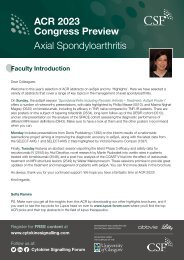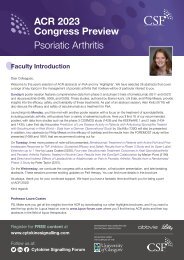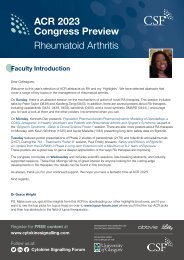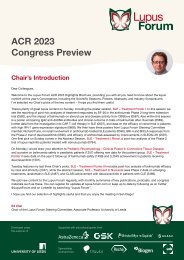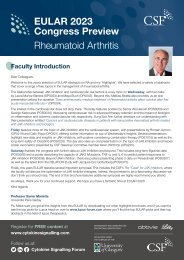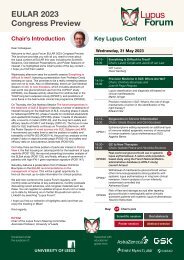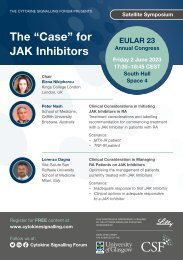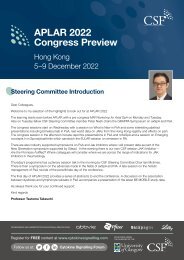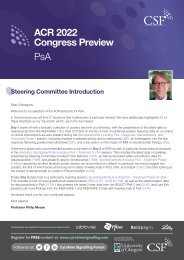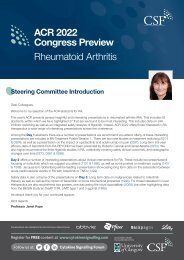ACR Congress Review 2019
You also want an ePaper? Increase the reach of your titles
YUMPU automatically turns print PDFs into web optimized ePapers that Google loves.
Update on JAK inhibitor safety data<br />
Upadacitinib<br />
Upadacitinib safety in the SELECT clinical program<br />
Findings from an integrated analysis of the upadacitinib safety profile from the SELECT Phase 3 clinical<br />
program were presented in three posters.<br />
Cohen and colleagues presented exposure-adjusted event rates (EAERs) and key safety data. Across<br />
the five Phase 3 trials, 3834 patients received one or more dose of upadacitinib 15 (n=2630) or 30 mg<br />
QD (n=1204). The EAERs of overall SAEs and AEs leading to discontinuation on upadacitinib 15 mg<br />
were comparable to adalimumab; while the rates of both were higher on upadacitinib 30 versus<br />
upadacitinib 15 mg and MTX. Rates of deaths were comparable across the treatment groups. Serious<br />
infection rates were comparable between upadacitinib 15 mg and adalimumab, while higher on<br />
upadacitinib compared with MTX. Rates of herpes zoster were higher in both upadacitinib groups versus<br />
MTX and adalimumab. The rates of serious infections and herpes zoster were higher on upadacitinib 30<br />
versus 15 mg. Rates of VTE, MACE, and malignancy were comparable with that observed in the MTX<br />
and adalimumab groups while also being consistent with reported rates in the RA population [509*].<br />
Choy and colleagues presented an analysis focusing on MACE and VTE. The EAERs of MACE and<br />
VTE in the upadacitinib groups were comparable to placebo, MTX and adalimumab. Approximately 40%<br />
of MACEs and 1 PE event (upadacitinib 15 mg) were fatal. All patients with a MACE or VTE event had<br />
one or more CV risk factors (hypertension, diabetes, dyslipidaemia) or one or more VTE risk factor (prior<br />
history of thrombotic event, obesity, or hypertension) at baseline, respectively. Treatment with<br />
upadacitinib increased the levels of LDL-C and HDL-C, however, their ratio remained constant over time<br />
and there was no association of LDL‐C increases and MACE occurrences. No dose‐response or pattern<br />
of time-to-VTE-onset was observed with either upadacitinib dose [846*].<br />
An integrated, long-term safety analysis of upadacitinib in Japanese patients was presented by<br />
Yamaoka and colleagues. The analysis included a total of 371 Japanese patients who received<br />
upadacitinib 7.5 (n=121), 15 (n=126), or 30 mg QD (n=124) in one of three clinical studies (SELECT-<br />
SUNRISE, SELECT-EARLY or SELECT-MONOTHERAPY). Among the Japanese population, EAERs<br />
were consistently higher in the 30 mg group compared with the 15 mg and 7.5 mg groups. EAERs in the<br />
15 mg and 7.5 mg groups were comparable. In comparison with the global population, EAERs in the 15<br />
mg and 30 mg groups was higher in the Japanese population. The EAER of infections (including herpes<br />
zoster) was also higher in the Japanese population compared with the global population. In contrast,<br />
EAERs of AESI (including malignancies, cardiovascular disorders, hepatic disorders, and laboratory<br />
abnormalities) were comparable between the Japanese and global populations [2407].<br />
Baricitinib<br />
Long-term baricitinib safety in RA<br />
The long-term safety and efficacy profile for baricitinib up to 7 years was presented by Genovese et al.<br />
The analysis included 3770 patients with RA (10,127 patient-years of exposure) from 9 randomised trials<br />
and an ongoing open-label, long-term extension study. No significant differences were seen for<br />
baricitinib 4 mg versus placebo in AEs leading to permanent drug discontinuation, death, malignancy,<br />
serious infection, or MACE. The incidence rate of herpes zoster was significantly higher for baricitinib<br />
4 mg versus placebo (3.8 versus 0.9) and numerically higher for baricitinib 2 mg (3.1). Incidence rates<br />
for DVT/PE were numerically higher in baricitinib 4 mg versus placebo. Malignancy (excluding<br />
*Chairman’s Pick



